Visit to 'Scotland'.UK February 2009
Who in their right mind would arrange to go to Scotland in Winter time!
Well when you love Scotland as we do you want to see it in all seasons and so we arranged to go back to celebrate my 70th Birthday,
And we picked the right week, the last occasion I saw Scotland with any quantity of snow on the mountains was back in 1960, when I went Ski-ing with the army staying in the Rothiemurhus estate, where the RAF had a wooden building used by it's staff..
We had arranged to travel, Fly in this case on the 13th of February, and on the 11th the Highlands received their largest fall of snow they have had for many years, we were told 11 years.
Inverness airport was closed for a large part of the day.
And even the city of Inverness which is situated at sea level had a substantial fall of snow which settled, we are assured that is quite unusual, although it does fall and settle on the higher ground around the city.
The main road A9, which would take us down to Aviemore, our intended destination was blocked for a time so it was a good job we didn't travel until the 13th.


However by the time we arrived on the 13th Inverness Airport was fully open and as was expected the main roads had been cleared and were fully passable, albeit there were still considerable amounts of snow along sides of the main roads.
The side roads however were in some instances a different story and some would have still been impassable, I think you will agree the old bridge in 'Carrbridge looked just a little different from when we visited in June/July last year.
And sorry to say it does look as though the weight of the snow has brought the conifer on the right side of the bridge down as indeed it had many other trees in the area.

As arranged we made journey to our destination on the 14th and stopped at one of our favourite spots 'Carrbridge' where icicles hung from the gutters of the houses, in some cases reaching eighteen inches to two feet in length and snow was banked up four feet deep at the road side.
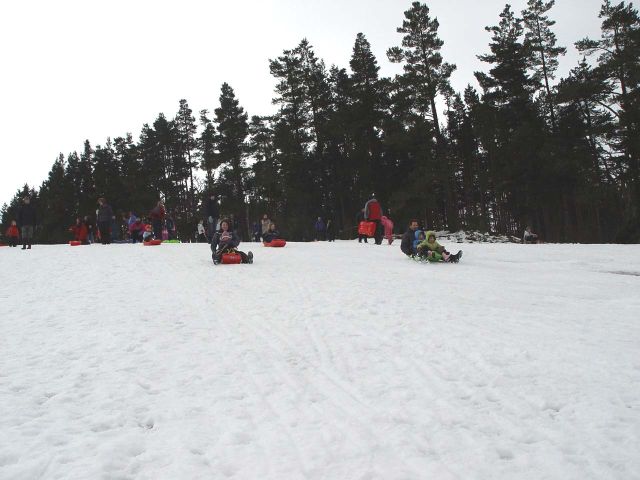
It's true to say that we spent most of the week in the Cairngorms region/Aviemore which was indeed very busy, the children were on half term and were having a great time in the snow which because Aviemore is above sea level was still very much covered in snow being deep in places
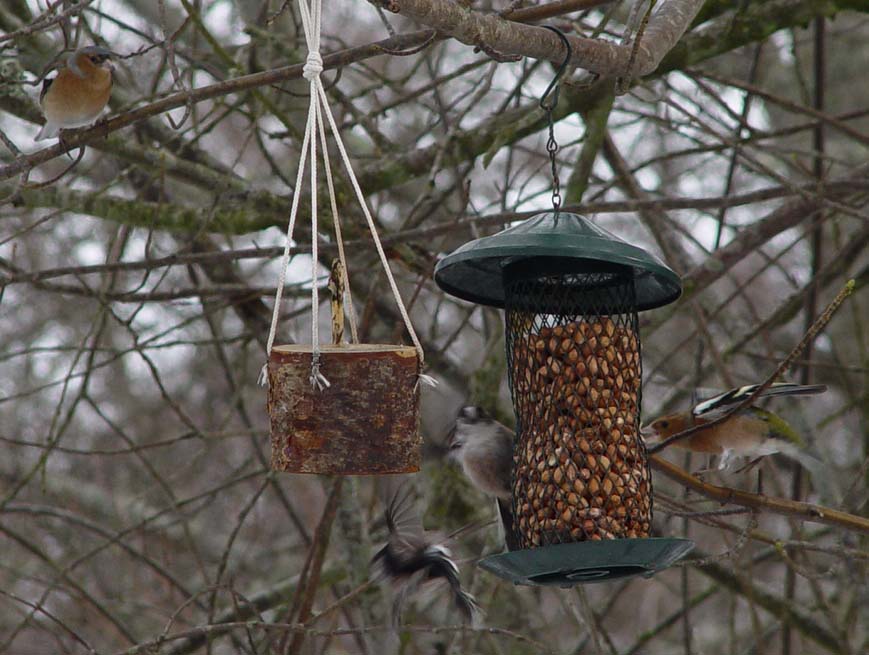
What is noticeable in Scotland is the affection the locals have for the wild life and their animals, there were plenty of bird feeders for the birds and red squirrels and the farm animals, Highland cattle which appear to be making a real come back in Scotland were well cared for.

These two young males were well dressed for the cold weather, and taking advantage of the hay just provided by their owner, who without doubt had a lot to do with the clearing of the side roads of the heavy snow fall.

The 'grey leg' geese however having returned for the winter were quite capable of looking after themselves settling where the grass was greenest!

On the resort we were staying 'Scandinavian Village' even the large Silver Burch tree trunk had been used to good advantage. In this case the owl had been carved by a Allis Burgess the wife of the originator of one of the other large carvings on site, a highland cow, which used the full trunk of a tree.

The Modern tractors now used being ideally suited to cutting a pathway through the snow.
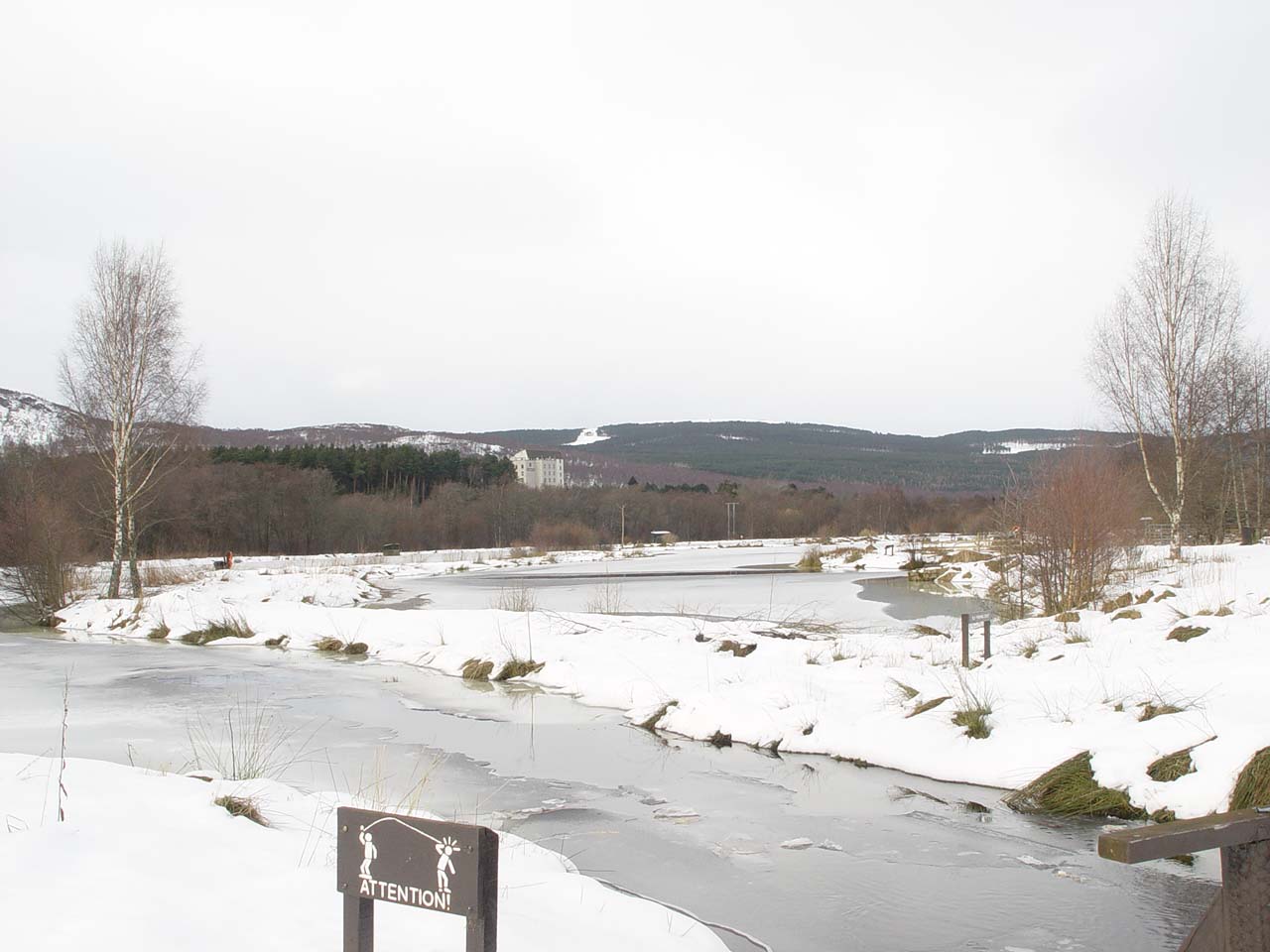
My normal occupation while in Aviemore of fly fishing for trout was out of the question on this visit, the lakes being almost completely frozen over, I could have set up a tent on the ice and cut and fished through a hole but it didn't have the same appeal so gave it a miss!
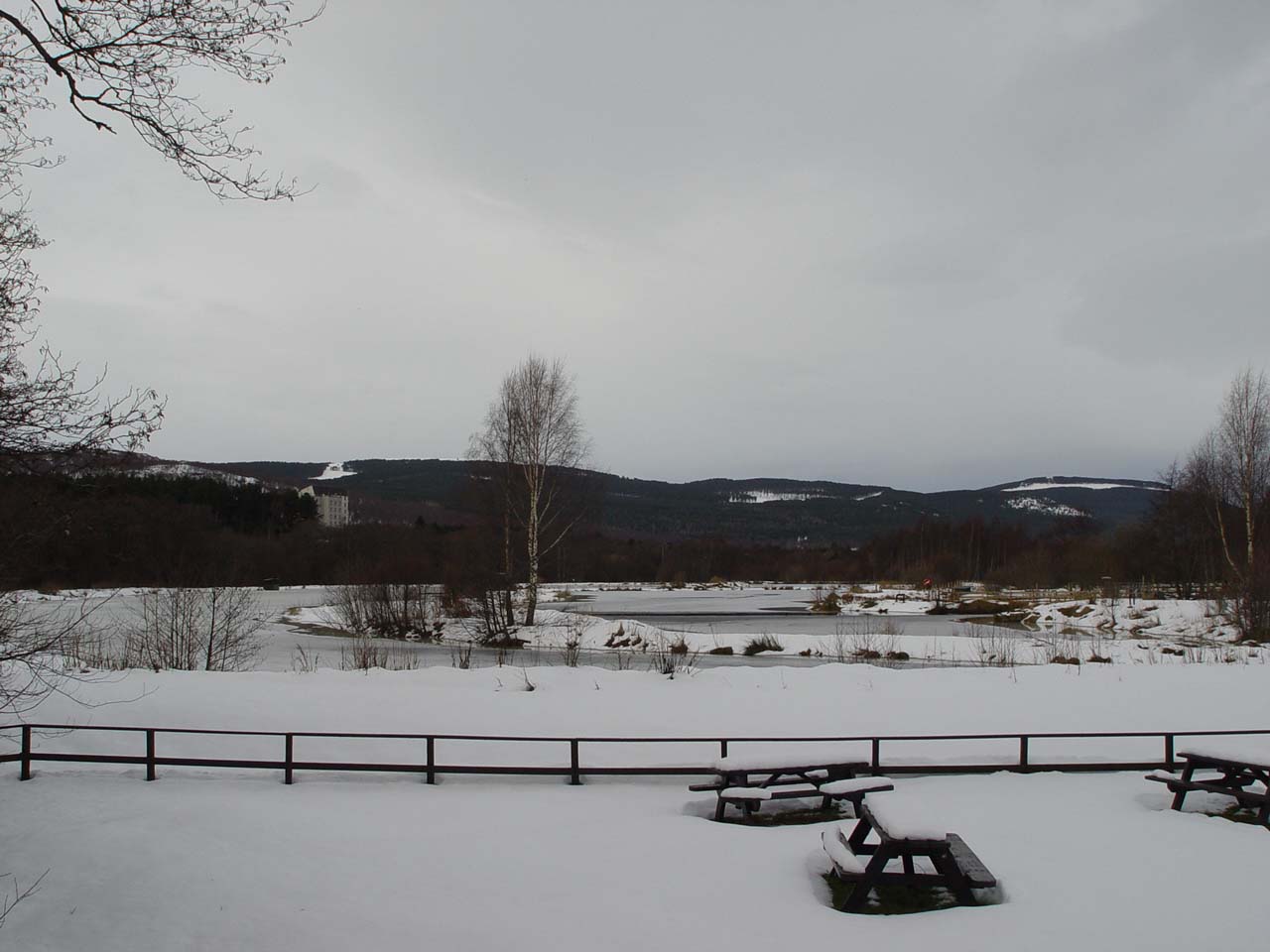
It wasn't even ideal conditions for a pic-nic as the tables were already occupied by in some places over a foot of snow! You certainly wouldn't have wanted an Ice bucket for the champagne?
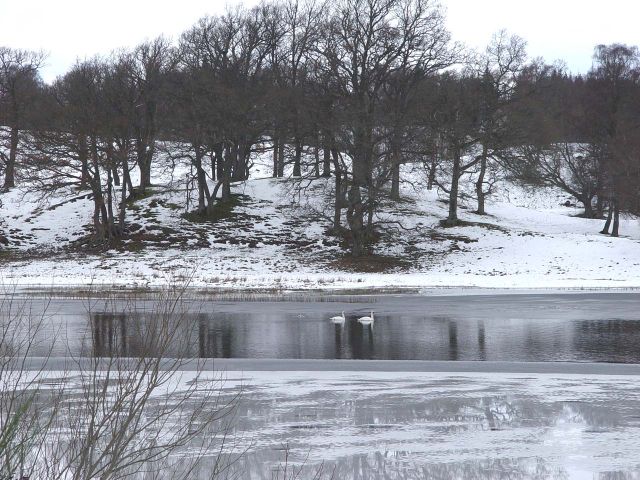
The swans in this photo I'm sure were pleased that the ice had thawed allowing them to at least swim in the river, a couple of days earlier that to had been frozen over.
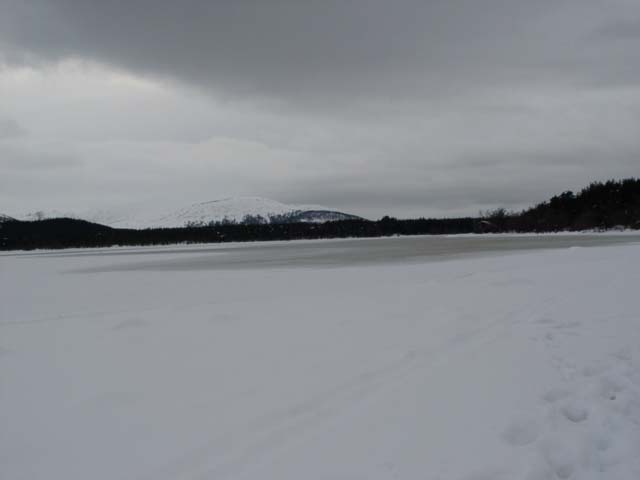
If you were a new visitor to the area you could be forgiven for not knowing the beneath this very large sheet of ice was 'Lock Morlich' you might not be forgiven if you had ventured onto it as some carefree visitors had obviously done.
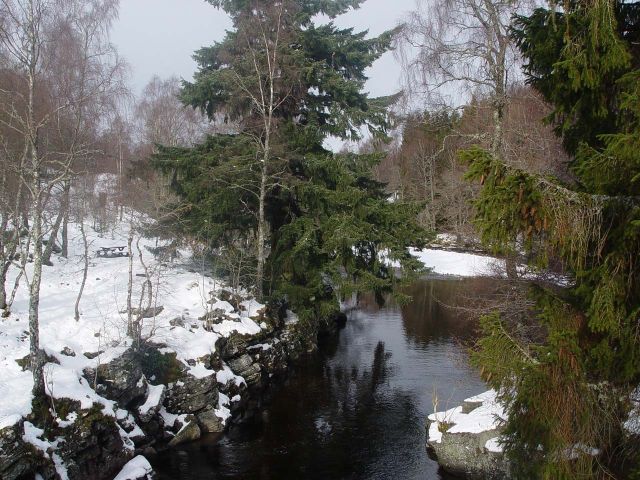
The wonderful views from our favourite spots were so different from the photos taken during our visit last year, June/July.
I never tire of visiting and seeing these wonderful spots which are within easy reach of Aviemore by car of bike.

Even the forest looked so different with it's white carpet, although in some places the weight of the snow had done considerable damage to the trees, breaking off large branches where they were unable to support the weight.
It appeared that it was the 'Scots pine' that had suffered most damage. No telling what has happened to the numerous Ospreys nests which of course they visit and use year after year.
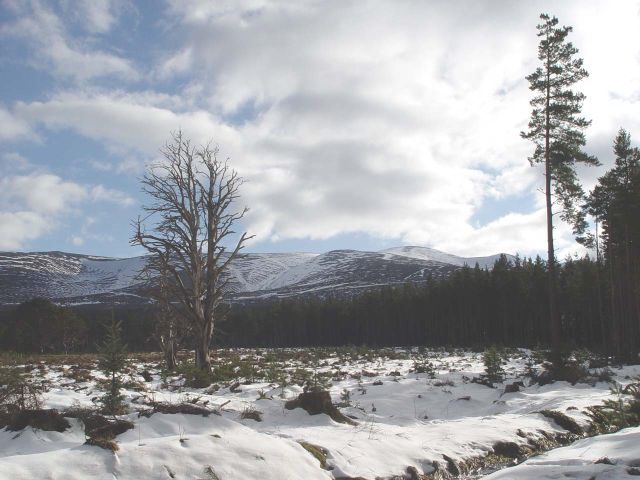
In this instance the Scots pine in the foreground has given up and is dead, but still adds to the view and harsh climate to which it has been exposed.
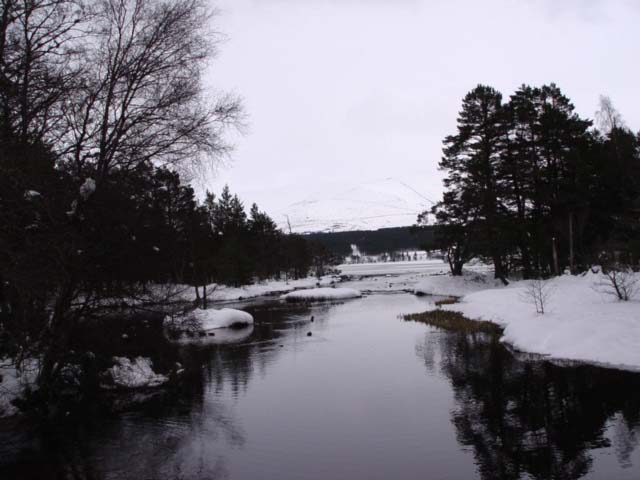

It's hard to believe that this is the same view, both are taken from the same view point, The 'Bailey bridge' without doubt erected by the forces way back in the fifties, which allows access to the RAF hut now known as the 'Rothiemurches hut' although now there are quite a few wooden building situated in the same area.
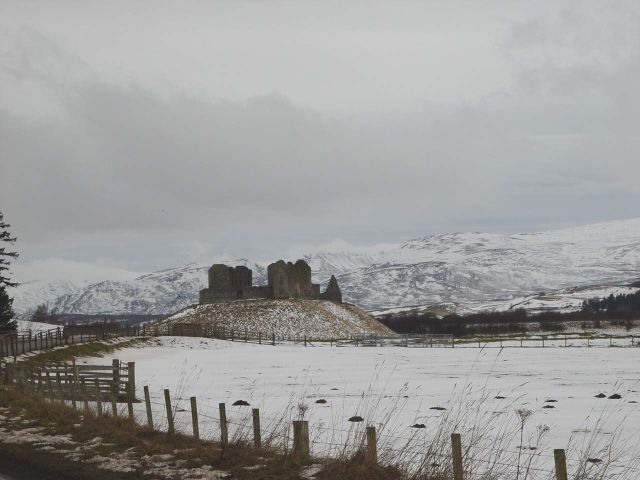
Even Ruthven Barracks, situated to the west of Aviemore, stands out with more dominance against the backdrop of snow, now doubt having seen far greater events and falls of snow during it's long history. Interesting to see the moles aren't put off by the snow above ,still creating havoc by pushing up large mounds of fresh soil obvious against the white surface of the field.
For more information :- Ruthven Barracks History.
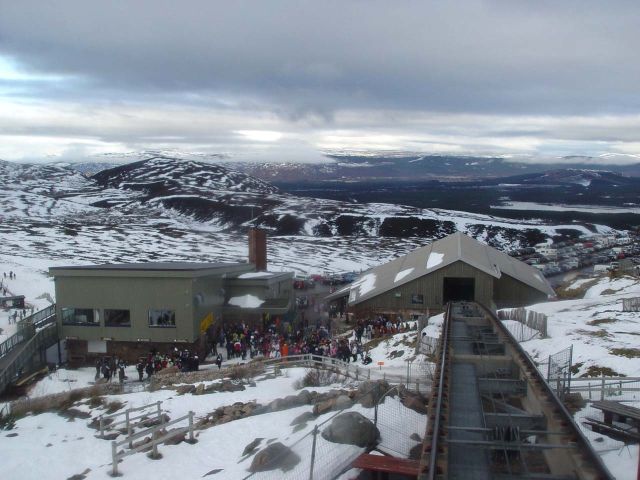
No visit to Aviemore is complete without a visit to the Cairngorms mountains that form a back drop to the south of the town.
And where we found hundreds of folk with the same idea? They had made their way to the ski-ing areas which were very busy indeed, no doubt to the pleasure of the company running the resort.
Car parks were simply over flowing with vehicles. There had been a decent fall of snow and every body was out to enjoy it.
The Funicular railway becomes the main form of transport to the ski-ing areas and was on both of our visits was very busy indeed.
Even the lower car parks were full with shuttle buses being provided for the occupants of vehicles that were unable to park in close proximity to the lower station.

On reaching the top station there was no doubt that there had been a large fall of snow it being banked up against these windows to at least a height of five feet

And walking outside was like venturing into a different world.
Normally quiet but now a hive of activity, with adults to very small children ski-ing and being encouraged by the parents to stand on their wee ski's, some being hardly big enough to stand.

Large purpose built machines which must cost thousands of ££££ were on hand to ensure the ski runs were in good order, and were kept busy pushing the snow to cover the areas where the snow had be blown thin by the wind, The stake fences that can be seen in the photos assist in the process by collecting the drifting snow that can then be distributed across the ski runs. thickness.
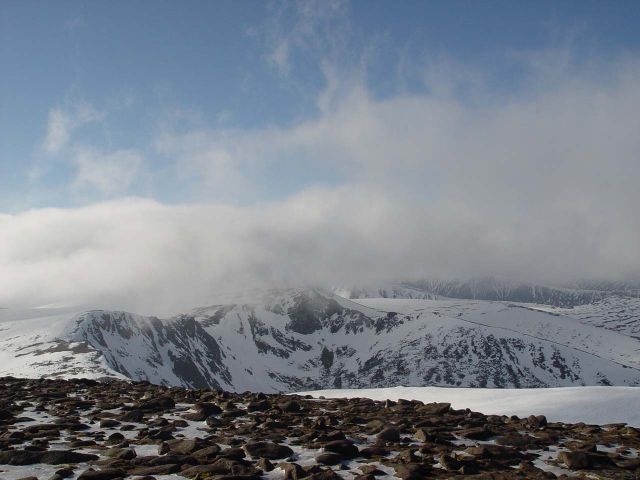
As mentioned on previous pages, in the summer months, passengers of the Funicular railway are asked not to leave the top station/restaurant area, as the area is classified as an 'area of outstanding national beauty' by the World heritage organisation.
However in the winter months when the Cairngorms Mountains are covered with snow no such rule applies, so many walkers and climbers were taking the opportunity to walk to the top of the Cairngorms mountain, enabling them to reach the stone cairn built by climbers over the years by placing individual stones to form a pyramid, seen on many of the high peaks in the scottish mountains.
A well worth climb although there were low clouds about along with sunny periods, making the views spectacular in a very special way.
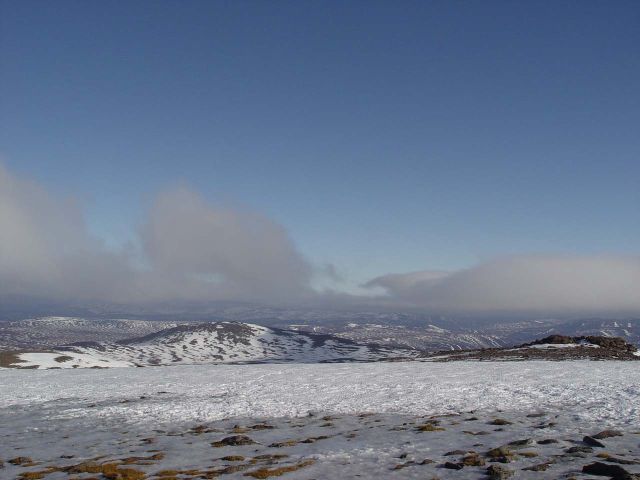
Even on a day when there were hundreds if not thousands of people on the mountains, wide open spaces existed where not a sole could be seen that along with the weather conditions changing in minutes from sunny and warm to Cold and foggy caused by the passing clouds, not the sort of place where you want to wondering alone.
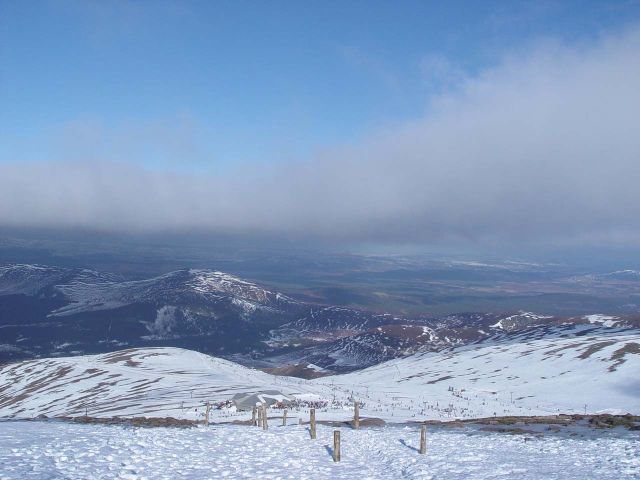
In the photograph the restaurant /top station can just be seen, the wooden posts forming a route to be taken to the top, thus keeping damage to a minimum and preserving the slow growing vegetation which lives in this very harsh wind swept environment.
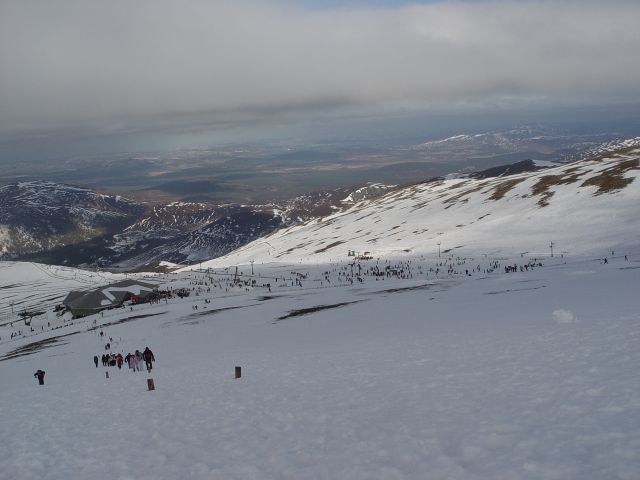
Mind you I wasn't alone, there were a great number of people with the same idea better equipped and in some cases younger.
With these wonderful views and the wonderful weather it was hard to visualise how there can be so many accidents and loss of life on this range of mountains . Only a few weeks prior to our visit climbers had lost their lives.
A wonderful spot but like the oceans and seas can be a killer, if not treated with the greatest respect at all times. Even while on the mountain the cloud dropped in minutes leaving you in a thick cold fog, only for to then again suddenly clear into a bright sunny day.
Loose you compass bearing and you could quickly become disorientated and be in trouble very quickly.

The Cairngorms weather station housed within the drum I understand collects weather data, the instruments apparently appearing every 20 minutes or so to collect data and then disappear back into the drum, there by preventing their permanent exposure to the elements. Cairngorms Weather Station (7th Dec 2006 ... Automatic Weather Station on Cairngorms summit operated by Heriot Watt University. Includes a web cam of the view from the summit.)
Visit the weather station for today's forecast:- http://www.phy.hw.ac.uk/resrev/weather.htm
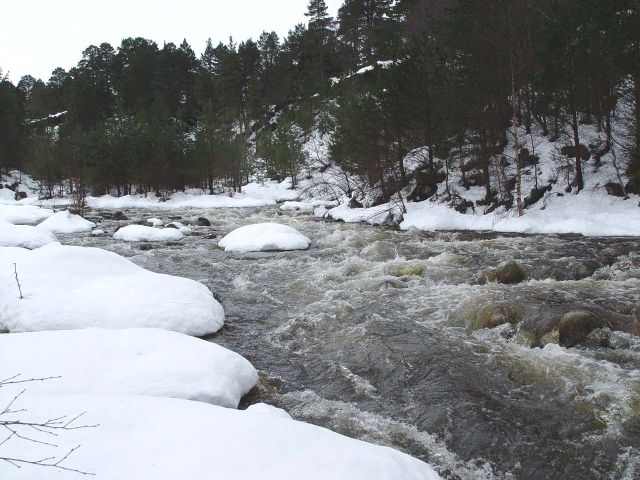
Even on your way back from the mountain there are spectacular views and things to see. In this case the thawing snow swelling the burns that run down from the mountains still banked by the fallen snow.
Next
Back to index
Well when you love Scotland as we do you want to see it in all seasons and so we arranged to go back to celebrate my 70th Birthday,
And we picked the right week, the last occasion I saw Scotland with any quantity of snow on the mountains was back in 1960, when I went Ski-ing with the army staying in the Rothiemurhus estate, where the RAF had a wooden building used by it's staff..
We had arranged to travel, Fly in this case on the 13th of February, and on the 11th the Highlands received their largest fall of snow they have had for many years, we were told 11 years.
Inverness airport was closed for a large part of the day.
And even the city of Inverness which is situated at sea level had a substantial fall of snow which settled, we are assured that is quite unusual, although it does fall and settle on the higher ground around the city.
The main road A9, which would take us down to Aviemore, our intended destination was blocked for a time so it was a good job we didn't travel until the 13th.
However by the time we arrived on the 13th Inverness Airport was fully open and as was expected the main roads had been cleared and were fully passable, albeit there were still considerable amounts of snow along sides of the main roads.
The side roads however were in some instances a different story and some would have still been impassable, I think you will agree the old bridge in 'Carrbridge looked just a little different from when we visited in June/July last year.
And sorry to say it does look as though the weight of the snow has brought the conifer on the right side of the bridge down as indeed it had many other trees in the area.
As arranged we made journey to our destination on the 14th and stopped at one of our favourite spots 'Carrbridge' where icicles hung from the gutters of the houses, in some cases reaching eighteen inches to two feet in length and snow was banked up four feet deep at the road side.
It's true to say that we spent most of the week in the Cairngorms region/Aviemore which was indeed very busy, the children were on half term and were having a great time in the snow which because Aviemore is above sea level was still very much covered in snow being deep in places
What is noticeable in Scotland is the affection the locals have for the wild life and their animals, there were plenty of bird feeders for the birds and red squirrels and the farm animals, Highland cattle which appear to be making a real come back in Scotland were well cared for.
These two young males were well dressed for the cold weather, and taking advantage of the hay just provided by their owner, who without doubt had a lot to do with the clearing of the side roads of the heavy snow fall.
The 'grey leg' geese however having returned for the winter were quite capable of looking after themselves settling where the grass was greenest!
On the resort we were staying 'Scandinavian Village' even the large Silver Burch tree trunk had been used to good advantage. In this case the owl had been carved by a Allis Burgess the wife of the originator of one of the other large carvings on site, a highland cow, which used the full trunk of a tree.
The Modern tractors now used being ideally suited to cutting a pathway through the snow.
My normal occupation while in Aviemore of fly fishing for trout was out of the question on this visit, the lakes being almost completely frozen over, I could have set up a tent on the ice and cut and fished through a hole but it didn't have the same appeal so gave it a miss!
It wasn't even ideal conditions for a pic-nic as the tables were already occupied by in some places over a foot of snow! You certainly wouldn't have wanted an Ice bucket for the champagne?
The swans in this photo I'm sure were pleased that the ice had thawed allowing them to at least swim in the river, a couple of days earlier that to had been frozen over.
If you were a new visitor to the area you could be forgiven for not knowing the beneath this very large sheet of ice was 'Lock Morlich' you might not be forgiven if you had ventured onto it as some carefree visitors had obviously done.
The wonderful views from our favourite spots were so different from the photos taken during our visit last year, June/July.
I never tire of visiting and seeing these wonderful spots which are within easy reach of Aviemore by car of bike.
Even the forest looked so different with it's white carpet, although in some places the weight of the snow had done considerable damage to the trees, breaking off large branches where they were unable to support the weight.
It appeared that it was the 'Scots pine' that had suffered most damage. No telling what has happened to the numerous Ospreys nests which of course they visit and use year after year.
In this instance the Scots pine in the foreground has given up and is dead, but still adds to the view and harsh climate to which it has been exposed.

It's hard to believe that this is the same view, both are taken from the same view point, The 'Bailey bridge' without doubt erected by the forces way back in the fifties, which allows access to the RAF hut now known as the 'Rothiemurches hut' although now there are quite a few wooden building situated in the same area.
Even Ruthven Barracks, situated to the west of Aviemore, stands out with more dominance against the backdrop of snow, now doubt having seen far greater events and falls of snow during it's long history. Interesting to see the moles aren't put off by the snow above ,still creating havoc by pushing up large mounds of fresh soil obvious against the white surface of the field.
For more information :- Ruthven Barracks History.
No visit to Aviemore is complete without a visit to the Cairngorms mountains that form a back drop to the south of the town.
And where we found hundreds of folk with the same idea? They had made their way to the ski-ing areas which were very busy indeed, no doubt to the pleasure of the company running the resort.
Car parks were simply over flowing with vehicles. There had been a decent fall of snow and every body was out to enjoy it.
The Funicular railway becomes the main form of transport to the ski-ing areas and was on both of our visits was very busy indeed.
Even the lower car parks were full with shuttle buses being provided for the occupants of vehicles that were unable to park in close proximity to the lower station.
On reaching the top station there was no doubt that there had been a large fall of snow it being banked up against these windows to at least a height of five feet
And walking outside was like venturing into a different world.
Normally quiet but now a hive of activity, with adults to very small children ski-ing and being encouraged by the parents to stand on their wee ski's, some being hardly big enough to stand.
Large purpose built machines which must cost thousands of ££££ were on hand to ensure the ski runs were in good order, and were kept busy pushing the snow to cover the areas where the snow had be blown thin by the wind, The stake fences that can be seen in the photos assist in the process by collecting the drifting snow that can then be distributed across the ski runs. thickness.
As mentioned on previous pages, in the summer months, passengers of the Funicular railway are asked not to leave the top station/restaurant area, as the area is classified as an 'area of outstanding national beauty' by the World heritage organisation.
However in the winter months when the Cairngorms Mountains are covered with snow no such rule applies, so many walkers and climbers were taking the opportunity to walk to the top of the Cairngorms mountain, enabling them to reach the stone cairn built by climbers over the years by placing individual stones to form a pyramid, seen on many of the high peaks in the scottish mountains.
A well worth climb although there were low clouds about along with sunny periods, making the views spectacular in a very special way.
Even on a day when there were hundreds if not thousands of people on the mountains, wide open spaces existed where not a sole could be seen that along with the weather conditions changing in minutes from sunny and warm to Cold and foggy caused by the passing clouds, not the sort of place where you want to wondering alone.
In the photograph the restaurant /top station can just be seen, the wooden posts forming a route to be taken to the top, thus keeping damage to a minimum and preserving the slow growing vegetation which lives in this very harsh wind swept environment.
Mind you I wasn't alone, there were a great number of people with the same idea better equipped and in some cases younger.
With these wonderful views and the wonderful weather it was hard to visualise how there can be so many accidents and loss of life on this range of mountains . Only a few weeks prior to our visit climbers had lost their lives.
A wonderful spot but like the oceans and seas can be a killer, if not treated with the greatest respect at all times. Even while on the mountain the cloud dropped in minutes leaving you in a thick cold fog, only for to then again suddenly clear into a bright sunny day.
Loose you compass bearing and you could quickly become disorientated and be in trouble very quickly.
The Cairngorms weather station housed within the drum I understand collects weather data, the instruments apparently appearing every 20 minutes or so to collect data and then disappear back into the drum, there by preventing their permanent exposure to the elements. Cairngorms Weather Station (7th Dec 2006 ... Automatic Weather Station on Cairngorms summit operated by Heriot Watt University. Includes a web cam of the view from the summit.)
Visit the weather station for today's forecast:- http://www.phy.hw.ac.uk/resrev/weather.htm
Even on your way back from the mountain there are spectacular views and things to see. In this case the thawing snow swelling the burns that run down from the mountains still banked by the fallen snow.
Next
Back to index